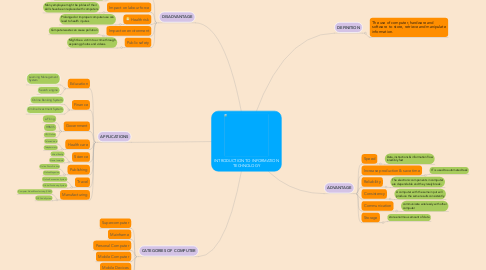
1. DISADVANTAGE
1.1. Violation of Privacy
1.1.1. Other person might steal our personal & confidential records if they were not protected properly.
1.2. Impact on labour force
1.2.1. Many employee might be jobless if their skills have been replaced with computers
1.3. Health risk
1.3.1. Prolonged or improper computer use can lead to health injuries
1.4. Impact on environment
1.4.1. Computer waste can cause pollution
1.5. Public safety
1.5.1. Might be a victim to a crime through exposing photos and videos.
2. APPLICATIONS
2.1. Education
2.1.1. Learning Management System
2.1.2. Search engine
2.2. Finance
2.2.1. Online Banking System
2.2.2. Online Investment System
2.3. Government
2.3.1. e-Filing
2.3.2. HRMIS
2.3.3. UPU Online
2.4. Health care
2.4.1. Telemedicine
2.4.2. Telepharmacy
2.5. Science
2.5.1. Virtual Reality
2.5.2. Neural network
2.6. Publishing
2.6.1. Online Photo Printing
2.6.2. Online Magazine
2.7. Travel
2.7.1. Online Reservation System
2.7.2. Global Positioning System
2.8. Manufacturing
2.8.1. Computer Aided Manufactuing (CAM)
2.8.2. QR Code System
3. CATEGORIES OF COMPUTER
3.1. Supercomputer
3.2. Mainframe
3.3. Personal Computer
3.4. Mobile Computer
3.5. Mobile Devices
3.6. Embedded Computer
4. DEFINITION
4.1. The use of computer, hardware and software to store, retrieve and manipulate information.
5. ADVANTAGE
5.1. Speed
5.1.1. Data, instructions & information flow inredibly fast
5.2. Increase production & save time
5.2.1. IT is used to automated task
5.3. Reliability
5.3.1. The electronic components in computer are dependable and they rarely break.
5.4. Consistency
5.4.1. A computer with the same input will produce the same results consistently
5.5. Communication
5.5.1. communicate wirelessly with other computer
5.6. Storage
5.6.1. store enormous amount of data

